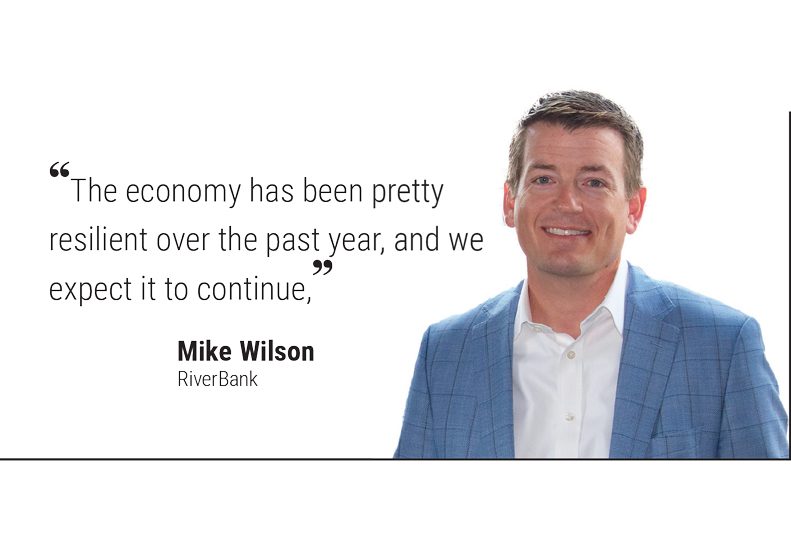
Home » Banking industry expects further stabilization in 2025
Banking industry expects further stabilization in 2025
Fraud, cybersecurity are among industry concerns

December 19, 2024
As financial services institutions wrap up the year, many expect continued steady growth and an overall return to stability in 2025, some Inland Northwest leaders in the industry say.
Steve Scranton, chief economist for Washington Trust Bank, says current growth is steady, especially in business deposits and demand for core business lending.
“We’re still seeing businesses that are growing, investing in new plants and equipment,” Scranton says.
Mike Wilson, CEO of Spokane-based RiverBank, concurs, noting that 95% of the organization's business focuses on business banking. The bank has had decent loan and deposit growth over 2024, and he expects that to continue into 2025.
According to the bank's most recent earnings report, loans totaled $206.9 million as of Sept. 30., up 10.2% compared with a year earlier.
“The economy has been pretty resilient over the past year, and we expect it to continue,” Wilson says. “Of course, with that optimism, we are cautious as we put together budgets and projections for next year.”
Lindsey Myhre, chief financial officer for Liberty Lake-based STCU, says the credit union industry expects slow to flat growth in the new year.
The booming years were at the height of the pandemic when financial institutions were flooded with one-time pandemic-era deposits, such as stimulus checks for consumers and Payment Protection Program funds for businesses, she says. Consumer prices shot up, and federal stimulus payments stopped, drying up deposits. Now, conditions are beginning to stabilize, but they aren't yet in a place of pre-pandemic economic health, she contends.
Scranton says short-term interest rates are expected to decrease, lowering borrowing costs for items like credit cards, vehicles, and lines of credit. However, long-term rates are expected to stay in the 6% to 7% range.
“I don’t think you’re going to see a move on mortgage rates,” Scranton says. “What we’ve seen is actually the opposite of that.”
Since the Federal Reserve started lowering interest rates this year, it has cut three-quarters of a percentage point and potentially will make it a full point by year-end, however, mortgage rates have gone up a half-percentage point, he says. There is more risk to investors with long-term loans, and inflation is still above the Federal Reserve’s 2% objective, Scranton adds.
According to the Bureau of Labor Statistics, as of November, the rate of inflation increased to 2.7% over the previous 12 months, down from a high of 9% in June of 2022.
Scranton says the Federal Reserve is expected to cut rates by 25 basis points at its Dec. 18 meeting.
Major obstacles that the financial services industry will continue to face are cybersecurity and fraud, particularly fraud that targets older people.
Myhre, of STCU, says account takeover is a major problem faced by customers.
“If I could say 30 times over, please do not give away your username and passwords,” Myhre says. “Everyone in our industry is battling that and developing strategies to beat it.”
Washington Trust Bank is dedicating more time and resources to educating customers on fraud and cybersecurity, Scranton says. Recently, the bank flagged an attempted $250,000 scam against one of its clients.
“The real problem is with the aging of the population, the scammers are getting more and more sophisticated,” Scranton says. “They are starting with what they think is easy to target.”
According to the Financial Crimes Enforcement Network, a federal agency that collects and analyzes white-collar crime data, U.S. financial institutions reported about $27 billion in elder financial exploitation related to suspicious activity from June 2022 to June 2023. The Federal Trade Commission, which is tasked with protecting consumers, notes that adults reported losing over $1.9 billion due to fraud in 2023.
Another potential headwind that organizations are tracking is the rate of loan delinquencies. Wilson, of RiverBank, says he monitors such leading indicators vigilantly.
“It’s in a good spot right now," he says of the rate of late payments on debts. "But that is something that is always somewhat unforeseen in terms of its impact on the expected performance of next year.”
Latest News Special Report Banking & Finance
Related Articles
Related Products





